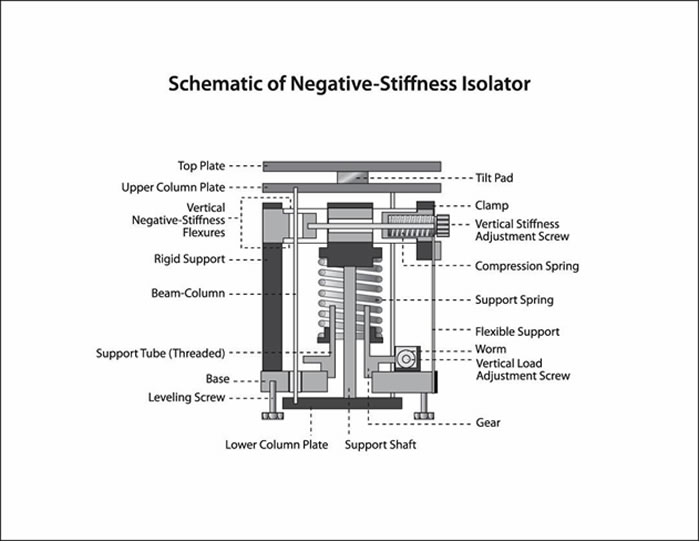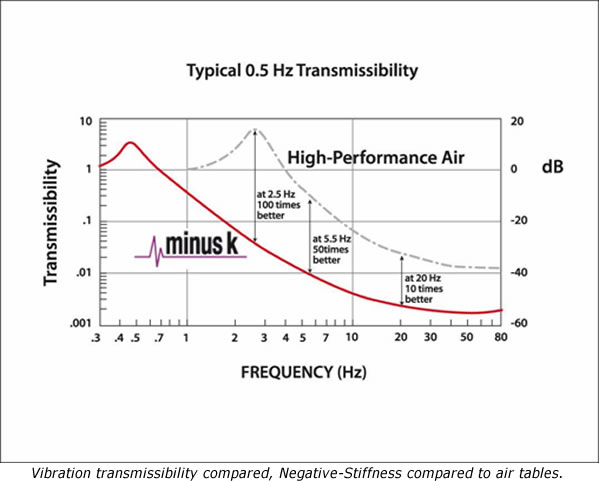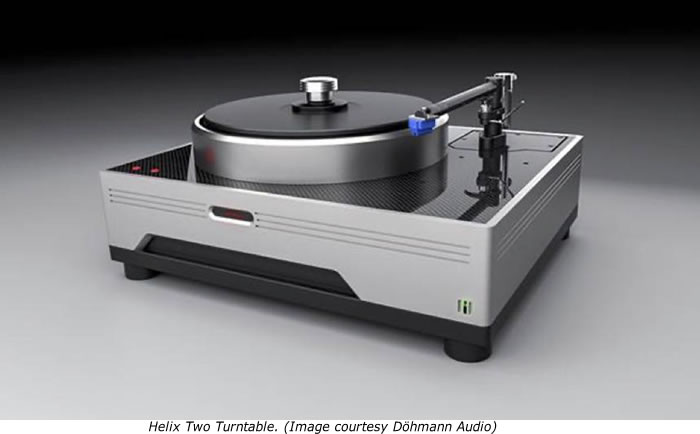
Ecoustics Online - September 2020
NEW PRODUCTS
Ultra-Thin Vibration Isolation Platform Debuts for High-End Audio Playback
The just-released model CT-2 completely-passive tabletop vibration isolation platform, from Minus K Technology, with no air or electric power required, represents the latest state-of-the-art option for audiophiles’ realization of the full dynamic playback potential from their turntables, CD transports and other high-end audio components.
At just under 2-3/4 inches in height with 0.5 Hz vertical and 1 1/2 Hz horizontal natural frequencies, the latest edition of the highest performing Negative-Stiffness vibration isolation systems for audiophiles has just gone ultra-thin and ultra-compact for optimized space configuration.
Developed in the 1990s to support the most critical laboratory research into nanotechnology, microelectronics, sub-atomic particle physics, spacecraft ground testing and biotechnology, Negative-Stiffness vibration isolation is widely accepted as state-of-the-art technology by the scientific community, and employed worldwide in over 300 universities and government research laboratories for their most exacting experiments in a broad spectrum of demanding applications. With this level of demonstrated vibration isolation performance, it didn’t take long for the audiophile community to catch on to Negative-Stiffness as a serious option for improving the integrity of audio playback. Today, Negative-Stiffness vibration isolation is the preferred standard for supporting high-end audio reproduction.
Since the early 2000s, Minus K Technology, the developer of Negative-Stiffness vibration isolation, has released several vibration isolation platforms for the high-end audio market, including the popular Model BM-8. These products have been accepted with high acclaim by audiophiles and audio system manufacturers worldwide. The Helix One® and Helix Two® turntables from Dohmann Audio, for example, come fully integrated with Negative-Stiffness vibration isolation.
According to Mark Dohmann, “The ability of Negative-Stiffness to deal with vibration and resonance is unsurpassed, and allows the music to be enjoyed with an outstanding level of realism.”
Whether audiophile or audio system manufacturer, the response after experiencing audio playback using a Negative-Stiffness system is ubiquitously similar to the popular Model BM-8.
“From the standpoint of its impact on a system’s sonic appeal, the Minus K 25BM-8 is all positive and its effects will likely come down somewhere between mind-blowing and subtle yet important.”John Potis / Six Moons.com
“I noticed two major areas of improvement to the analog presentation with the BM-8 in my system: Tighter, more tuneful bass and better resolution of low-level detail. I could really hear my system take a big jump in low level resolution. This was one of those improvements to your system that makes you go right to a lot of your favorite records just to get a quick read on the sound!”Jeff Dorgay / TONEAudio
“A Minus-k vibration isolation system should be considered mandatory by anyone who is serious about vinyl playback. This upgrade to my analog source has allowed me to hear everything that is on the LP by thoroughly isolating the playback system from ambient vibrations. It is difficult to overstate the benefits of this level of isolation to analog music reproduction. It’s now possible to appreciate the full scale and dynamic range of an LP recording.”Stephen Levene, PhD / Audiophile and Biophysicist
“Negative-Stiffness isolators enable a sense of harmonic rightness. Instruments sound much more like real instruments, and voices sound like they are in a real acoustic space, with real air around them. The ability to “see” clearly into the entire three-dimensional soundstage is greatly enhanced. Improvements in rhythm and pace are captivating.” Eric Jacobs / The Audio Archive
“The BM-8 is simply an amazing vibration platform product that provides an impressive degree of isolation from vibration distortions, resulting in definitive sonic refinement. Recommended! The BM-8 has no competition in this regard and is a MUST HAVE component in an enthusiast’s system.”Gary Reber / Widescreen Review
Aside from the acknowledgment of its technical performance, Minus K’s Negative-Stiffness vibration isolators have generated considerable interest because they operate as a totally passive device. No vacuum pump, and none of the extra noise that goes with a pump or the complexity that it brings to an audio system. Similarly, it does not use electricity. If audio systems can be isolated from vibrations without having to deal with compressed air or electricity, then it makes for a system that is simpler to install, easier to set-up, and more reliable to operate and maintain over the long-term.
Ultra-Thin Vibration Isolation Platform
Minus K’s Negative-Stiffness platforms are known for isolating vibration down to 0.7 Hz vertical frequency, which has set the low-frequency standard for vibration isolation, not just in audio reproduction, but in ultra-sensitive nanotechnology scientific research. But achieving this level of isolation required a platform of at least four inches in height, because of engineering constraints. For some audiophiles this posed a problem with space constraints, as their turntables would be positioned on top of the isolator.
Now, after considerable engineering, Minus K has released the first ultra-thin and ultra-compact Negative-Stiffness vibration isolator, designed specifically for optimized space configuration. The just-released model CT-2 completely-passive tabletop vibration isolation platform, with no air or electric power required, represents the latest state-of-the-art option for audiophiles’ realization of the full dynamic playback potential from their turntables, CD transports and other high-end audio components.
This unit is just under 2-3/4 inches in height, yet delivers 0.5 Hz vertical, and 1-1/2 Hz horizontal natural frequencies. Considerably more low-frequency vibration isolation performance compared to air tables and active systems.
“In Negative-Stiffness vibration isolation, vertical-motion isolation is provided by a stiff spring that supports a weight load, combined with a Negative-Stiffness mechanism,” explained Erik Runge, inventor of the technology enabling the CT-2 isolation platform. “The net vertical stiffness is made very low without affecting the static load-supporting capability of the spring. Special flexures connected in series with the vertical-motion isolator enable the very low height, horizontal-motion isolation. The result is a compact passive isolator capable of low vertical and horizontal natural frequencies and high internal structural frequencies.”

External When adjusted to 0.5 Hz vertical natural frequency (isolation begins at 0.7 Hz), the CT-2 Negative-Stiffness isolator achieves approximately 93 percent isolation efficiency at 2 Hz; 99 percent at 5 Hz; and 99.7 percent at 10 Hz.

As with all other Negative-Stiffness isolation platforms from Minus K, the CT-2 has no motors, pumps or chambers, and no maintenance because there is nothing to wear out. Here’s what one of the first purchasers of the new CT-1 (the precursor to the CT-2) had to say…
“I have now tried the CT-1 with the SAT top platform – the results are spectacular! I took a look at the mechanism inside of the CT-1 and I have to say I am very impressed with the ingenious work you have done. It provides most of its big brother’s performance in an extremely compact package that looks very slick. The arrangement and the finish of the mechanism is an engineer’s dream and it should be proudly displayed.”
“The equipment supported by the CT-1is well isolated from vibrations from 0.5 to 100 Hz, with much deeper, clearer base and more information in the lower frequencies. The CT-1 makes a huge difference in sound quality.”Marc Gomez, President / Swedish Analog Technologies – SAT
Vibration versus Sound Quality
The release of this ultra-thin, very low height vibration isolation platform, now makes it that much easier for audiophiles to incorporate Negative-Stiffness into their high-end audio set-ups.
Vibration isolation in the playback process of high-end audio systems is crucial. Any external vibration, no matter how slight, even someone walking near the turntable or vibration from floor-mounted speakers, is sensed by the turntable’s stylus and affects the sound being played back from the record. Capacitors, resistors, transistors, tube amplifiers and other electronic components are likewise sensitive to vibration.
External to the building, audio equipment can be influenced by vibrations from adjacent road traffic, nearby construction, loud noise from aircraft, and even wind and other weather conditions that can cause movement of the structure.
Vibrations in the range of 2 hertz (Hz) to 20,000 Hz will influence the sound reproduction in audio systems. But these internal and external influences primarily cause lower frequency vibrations which are transmitted through the structure, creating strong disturbances in sensitive, high-end audio systems. Depending on how far away the audio system is from these vibration sources, and where in the structure the audio system is located, whether on the third floor or in the basement, for example, will determine how strongly the sound quality will be influenced.

It’s All About the Sound
“Analog audiophile aficionados talk about blackberry notes, where the base is too prominent and muddy,” explained Dohmann. “This is often caused by a reinjection of vibration into the playback mechanism, adding to the amplitude of the needle movement and creating more signal that what is physically in the groove. But Negative-Stiffness vibration isolation cleans this up, so that the base is more natural. The timbre of the instrument used to produce the base, whether a string, piano or drum, sounds more like the real thing. It enables a sense of peace and calm to the playback.”
This latest generation of Negative-Stiffness vibration isolation technology, embodied within the CT-2, truly represents a significant advance in sound quality in a very compact package for high-end audio perfectionists.
by Jim McMahon
Jim McMahon writes on advancements in instrumentation technology. His features have appeared in hundreds of publications worldwide. jim.mcmahon@zebracom.net
About Minus K Technology, Inc.
Minus K® Technology, Inc. was founded in 1993 to develop, manufacture and market state-of-the-art vibration isolation products based on the company’s patented negative-stiffness technology. Minus K products are used in a broad spectrum of applications including microscopy, nanotechnology, biological sciences, semiconductors, materials research, zero-g simulation of spacecraft, and high-end audio.
The company is an OEM supplier to leading manufacturers of scanning probe microscopes, micro-hardness testers and other vibration-sensitive instruments and equipment. Minus K customers include private companies and more than 300 leading universities and government laboratories in 52 countries.
Erik Runge is Director of Engineering at Minus K Technology, having been with the company for 18 years. He attended UC Santa Barbara, where he earned a B.A. in Physics. While at UCSB, he was employed in the Hansma lab (Dr. Paul Hansma), and was involved with design of advanced Atomic Force Microscope (AFM) prototypes and their sub-systems. After graduation, Mr. Runge was a project engineer for Digital Instruments (AFM manufacturer) and worked on all levels of AFM development, eventually specializing in acoustic and vibration enclosures. At Minus K, he has designed every isolator currently offered, except one. He has done numerous custom isolation designs, and is intimately involved in all stages of new product development and engineering.
For more information on negative-stiffness isolators please contact Steve Varma, Minus K Technology, Inc.; 460 Hindry Ave., Unit C, Inglewood, CA 90301; Phone 310-348-9656; Fax 310-348-9638; email sales@minusk.com; www.minusk.com.
 The new Negative-Stiffness CT-2 ultra-thin, low-height, low-frequency vibration isolation platform mitigates space constraints in audio applications
The new Negative-Stiffness CT-2 ultra-thin, low-height, low-frequency vibration isolation platform mitigates space constraints in audio applications
|

